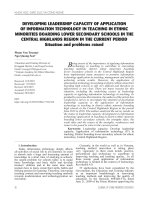INDRAPRASTHA INSTITUTE OF INFORMATION TECHNOLOGY DELHI ECE321521 LECTURE – 7
Bạn đang xem bản rút gọn của tài liệu. Xem và tải ngay bản đầy đủ của tài liệu tại đây (2.62 MB, 36 trang )
Indraprastha Institute of ECE321/521
Information Technology Delhi
Lecture – 7 Date: 28.01.2017
• Admittance Smith Chart
• High Frequency Network Analysis (intro)
• Impedance, Admittance and Scattering Matrix
• Matched, Lossless, and Reciprocal Networks
Indraprastha Institute of ECE321/521
Information Technology Delhi
Admittance Transformation
• RF/Microwave network, similar to any electrical network, has impedance elements
in series and parallel
• Impedance Smith chart is well suited while working with series configurations
while admittance Smith chart is more useful for parallel configurations
• The impedance Smith chart can easily be used as an admittance calculator
zin (z) 1 z yin z Yin z 1/ Zin z 1 1
1z Y0 1 / Z0 Zin z / Z0 zin z
• Hence, yin z 1 z 1 e j z
1 z yin z j
1e z
It means, to obtain normalized admittance → take the normalized impedance
and multiply associated reflection coefficient by -1 = e-jπ → it is equivalent to
a 180⁰ rotation of the reflection coefficient in complex Γ-plane
Indraprastha Institute of ECE321/521
Information Technology Delhi
Example – 1
• Convert the following normalized input impedance 𝑧𝑖𝑛′ into normalized
input admittance 𝑦𝑖𝑛′ using the Smith chart:
zin' 1 j1 2e j( /4)
First approach: The normalized admittance can be found by direct inversion as:
yin' '1 1 1 e j( /4) 1 j 1
zin 1 j1 2 22
Alternative approach:
• Mark the normalized impedance on Smith chart
• Identify phase angle and magnitude of the associated reflection coefficient
• Rotate the reflection coefficient by 180⁰
• Identify the x-circle and r-circle intersection of the rotated reflection
coefficient
Indraprastha Institute of ECE321/521
Information Technology Delhi
Normalized
Example – 1 (contd.) impedance (zin’) is the
intersection of r-circle
Quick investigation of 1 and x-circle of 1
shows that the
normalized Rotate this by 180⁰
to obtain normalized
impedance (yin’ ) is
the intersection of admittance
r-circle of 1/2 and
x-circle of -1/2
To denormalize, multiply
with the inverse of Z0.
Yin yin' 1 Y0 yin'
Z0
Indraprastha Institute of ECE321/521
Information Technology Delhi
Example – 2
Given: zin' 1 j2
• Find the normalized admittance l/8 away from the load
Steps:
1. Mark the normalized impedance on Smith Chart
2. Clockwise rotate it by 180⁰
3. Identify the normalized admittance and the phase angle of the
associated reflection coefficient
4. Clockwise rotate the reflection coefficient (associated with the
normalized admittance) by 2βl (here l = λ/8)
5. The new location gives the required normalized admittance
Indraprastha Institute of ECE321/521
Information Technology Delhi
zin' 1 j2
Example – 2 (contd.)
180⁰ clockwise
yin' 0.20 j0.40 rotation
Clockwise rotation by
l
2l 4
l
yin' 0.2 j0.4
l l / 8 2l 90o
Indraprastha Institute of ECE321/521
Information Technology Delhi
Admittance Smith chart
• Alternative approach to solve parallel network elements is through 180⁰
rotated Smith chart
• This rotated Smith chart is called admittance Smith chart or Y-Smith chart
• The corresponding normalized resistances become normalized
conductances & normalized reactances become normalized suceptances
r R g G Z0G
Z0 Y0
x X b b Z0B
Z0 Y0
• The Y-Smith chart preserves:
• The direction in which the angle of the reflection coefficient is
measured
• The direction of rotation (either toward or away from the generator)
Indraprastha Institute of ECE321/521
Information Technology Delhi
Angle of reflection
Admittance Smith chart (contd.) coefficient
Negative Values of
Suceptances
→Inductive Behavior
Open Circuit Positive Values of
Suceptances
→Capacitive
Behavior
Short Circuit
In this chart, admittance is represented in exactly the Real Component of Admittances
same manner as the impedance in the Z-smith Chart Decrease from Left to Right
→ without 180⁰ rotation
Indraprastha Institute of ECE321/521
Information Technology Delhi
Red: Z – Smith Chart
Combined Z- and Y- Smith Charts
Blue: Y – Smith Chart
Indraprastha Institute of ECE321/521
Information Technology Delhi
Example – 3
• Identify (a) the normalized impedance z’ = 0.5 + j0.5, and (b) the normalized
admittance value y’ = 1 + j2 in the combined ZY-Smith Chart and find the
corresponding values of normalized admittance and impedance
y' 1 j1 z' 0.5 j0.5
z' 0.2 j0.4 y' 1 j2
Indraprastha Institute of ECE321/521
Information Technology Delhi
High Frequency Networks
• Requirement of Matrix Formulation
Current/Voltage or directional coupler Current/Voltage or
Incident/Reflected (more than one port) Incident/Reflected
Traveling Wave Traveling Wave
NO!! These are called Can we characterize this
networks using an impedance or
What is the way? admittance!
Impedance or Admittance Matrix. Right?
In principle, N by N impedance matrix completely characterizes a linear N-
port device. Effectively, the impedance matrix defines a multi-port device the
way a ZL describes a single port device (e.g., a load)
Linear networks can be completely characterized by parameters measured at
the network ports without knowing the content of the networks.
Indraprastha Institute of ECE321/521
Information Technology Delhi
Multiport Networks
• Networks can have any number of ports – however, analysis of a 2-port,
3-port or 4-port network is sufficient to explain the theory and the
associated concepts
I1 I2
Port 1 + 2 Port + Port 2
V1 Network V2
- -
• The ports can be characterized with many parameters (Z, Y, S, ABCD). Each
has a specific advantage.
• For 2-port Network, each parameter set is related to 4 variables:
o 2 independent variables for excitation
o 2 dependent variables for response
Indraprastha Institute of ECE321/521
Information Technology Delhi
The Impedance Matrix Four identical TLs
used to connect
• Let us consider the following 4-port network: this network to the
outside world
This could be a I2 (z2 )
simple linear device V2 (z2 ) I3 ( z3 )
or a large/complex
Port-2 z2 z2P V3 ( z3 )
linear microwave
system Z0 Port-3
z3P
Either way, the I1 ( z1 ) Port-1 Z0
network can be fully z3 Each TL has
V1 ( z1 ) 4-port specific location
described by its Z0 Linear Microwave z4 z4P that defines input
impedance matrix impedances to
z1 Network
the network
z1P
Z0
Port-4
I4 (z4 )
V4 (z4 )
The arbitrary locations are known as ports of the network
Indraprastha Institute of ECE321/521
Information Technology Delhi
The Impedance Matrix (contd.) Vn (zn znP ) In (zn znP )
• In principle, the current and voltages at
the port-n of networks are given as:
• However, the simplified Vn Vn (zn znP ) In In (zn znP )
formulations are:
• If we want to say that there exists a non-zero I2 I3 I4 0
current at port-1 and zero current at all other I1 0
ports then we can write as:
need to measure/determine the associated voltages and currents at • In order to define the elements of impedance matrix, there will be Z21 IV2
the respective ports. Suppose, if we measure/determine current at 1
port-1 and then voltage at port-2 then we can define:
• Similarly, the trans-impedance Z31 V3 Z41 V4 Trans-impedance
parameters Z31 and Z41 are: I1 I1
• We can also define other trans-impedance parameters such as Z34 as the ratio
between the complex values I4 (the current into port-4) and V3 (the voltage at
port-3), given that the currents at all other ports (1, 2, and 3) are zero.
Indraprastha Institute of ECE321/521
Information Technology Delhi
The Impedance Matrix (contd.)
• Therefore, the more generic Zmn Vm (given that Ik = 0 for all k≠n)
form of trans-impedance is: In
How do we ensure that all but one port current is zero?
• Open the ports I 0 V2 Port-2
where the current 2 Z0
needs to be zero: I1
I3 0
4-port Linear The ports should
V1 Z0 Microwave Z0 V3 be opened! not
Network the TL connected
Port-1 to the ports
Port-3
I4 0 Z0 Port-4
V4
• then define the respective Z Vm (given that all ports k≠n are open)
mn
trans-impedances as: In
Indraprastha Institute of ECE321/521
Information Technology Delhi
The Impedance Matrix (contd.)
• Once we have defined the trans-impedance terms by opening various ports, it is
time to formulate the impedance matrix
• Since the network is linear, the voltage at any port due to all the port currents is
simply the coherent sum of the voltage at that port due to each of the currents
• For example, the voltage at port-3 is: V3 Z34I4 Z33I3 Z32I2 Z31I1
• Therefore we can generalize the N
voltage for N-port network as: Vm Zmn In V = ZI
n1
• Where I and V are T T
vectors given as:
V = V1, V2, V3, ...., VN I = I1, I2, I3, ...., IN
Z11 Z12 Z1n
• The term Z is matrix given by: Z Z21
Impedance Matrix
Zm1 Zm2 Zmn
• The values of elements in the impedance Z11() Z12 () Z1n ()
Z ()
matrix are frequency dependents and often it Z( ) 21
is advisable to describe impedance matrix as:
Z () Z ()
m1 m2 Zmn ()
Indraprastha Institute of ECE321/521
Information Technology Delhi
The Admittance Matrix
• Let us consider I2 (z2 ) z2 z2P This can be
the 4-port V2 (z2 ) characterized using
network again: Port-2 admittance matrix – if
Z0
I1(z1) Port-1 Port-3 I3(z3) currents are taken as
4-port Linear dependent variables
Microwave instead of voltages
V1 ( z1 ) Z0 Network Z0 V3 ( z3 )
z1 z1P z3 z3P
Port-4 Z0 z4 z4P The elements of admittance
matrix are called trans-
I4 (z4 )
V4 (z4 ) admittance parameters Ymn
• The trans-admittances Y Im (given that Vk Important: Ymn 1
Ymn are defined as: mn Vn = 0 for all k ≠
Z mn
n)
Indraprastha Institute of ECE321/521
Information Technology Delhi
The Admittance Matrix (contd.) I2 V2 0 Port-2
Z0
• the voltage at all but one port
must be equal to zero. This can I1 I3
be ensured by short-circuiting
the voltage ports. 4-port Linear Z0 V3 0
V1 Z0 Microwave
The ports should be short- Network
circuited! not the TL
Port-1 Port-3
connected to the ports
I4 Port-4 Z0
V4 0
• Now, since the network is linear, the current at any one port due to all the port
voltages is simply the coherent sum of the currents at that port due to each of
the port voltages.
• For example, the current at port-3 is: I3 Y34V4 Y33V3 Y32V2 Y31V1
• Therefore we can generalize the N
current for N-port network as: Im YmnVn I = YV
n1
Indraprastha Institute of ECE321/521
Information Technology Delhi
The Admittance Matrix (contd.)
• Where I and V are V = V1, V2, V3, ...., VN T T
vectors given as: I = I1, I2, I3, ...., IN
• The term Y is matrix given by: • The values of elements in the admittance
matrix are frequency dependents and
Y11 Y12 Y1n often it is advisable to describe
Y Y21 admittance matrix as:
Y11 ( ) Y12 () Y1n ()
Y( ) Y21() Ym2 ()
Ym1 Ym2
Ymn
Admittance Matrix Ym1 ( )
Ymn ()
You said that: Ymn 1
Z mn
Answer: Let us see if
Is there any relationship between we can figure it out!
admittance and impedance matrix of a
given device?
Indraprastha Institute of ECE321/521
Information Technology Delhi
The Admittance Matrix (contd.) I = YV
• Recall that we can determine the inverse of a matrix. Denoting
the matrix inverse of the admittance matrix as Y−1, we find:
Y1I = Y1 YV Y1I = Y1Y V Y1I = V
• We also know: V = ZI Z = Y1 OR Y Z 1
Reciprocal and Lossless Networks
• We can classify multi-port devices or networks as either lossless or lossy;
reciprocal or non-reciprocal. Let’s look at each classification individually.
Lossless Network
• A lossless network/device is simply one that cannot absorb power. This does not
mean that the delivered power at every port is zero; rather, it means the total
power flowing into the device must equal the total power exiting the device.
• A lossless device exhibits an impedance matrix with an interesting Re(Zmn ) 0
property. Perhaps not surprisingly, we find for a lossless device
that the elements of its impedance matrix will be purely reactive: For a lossless
device









